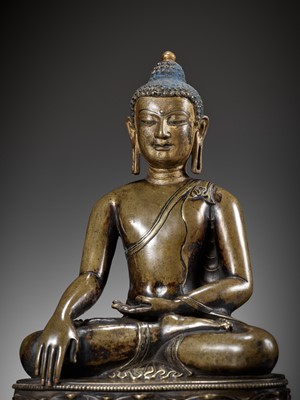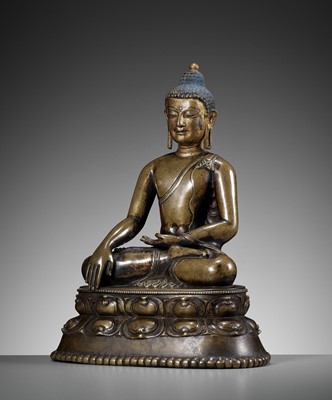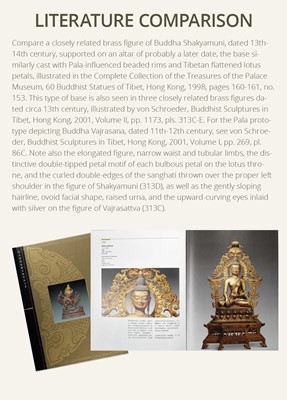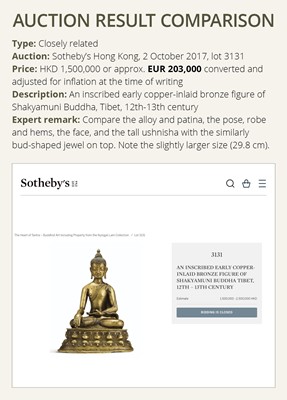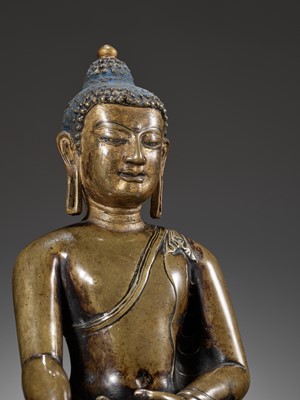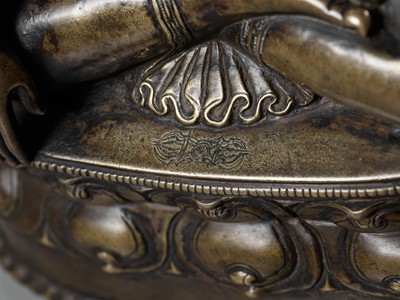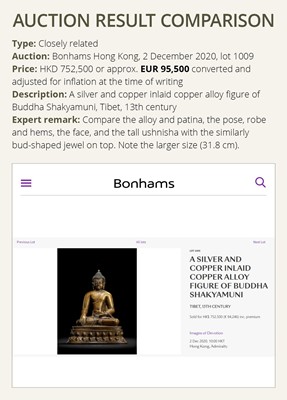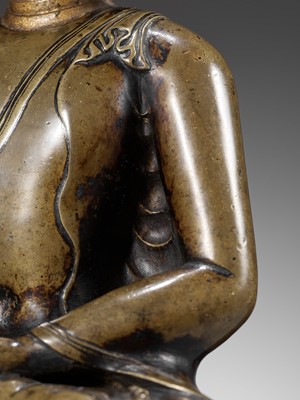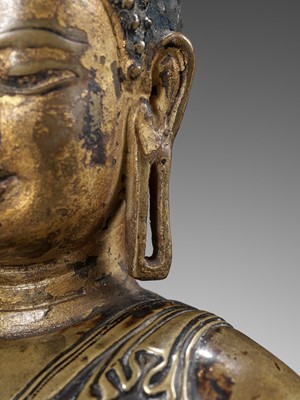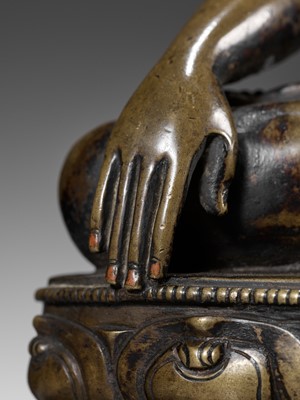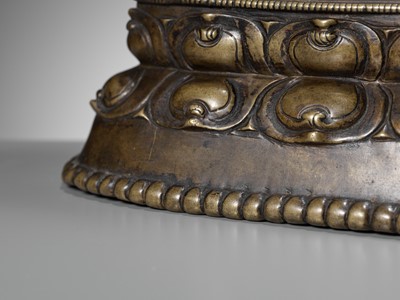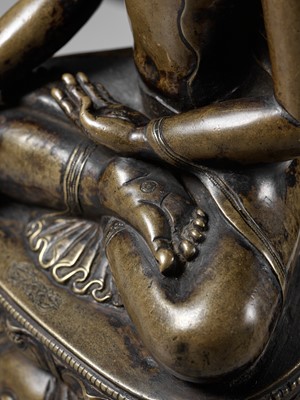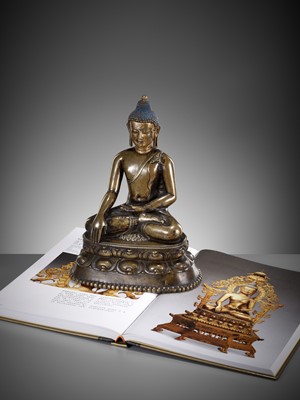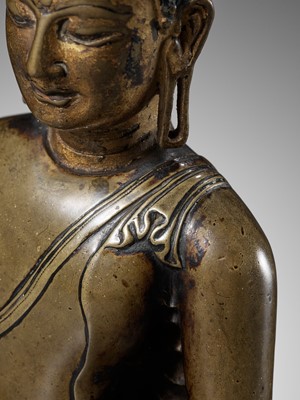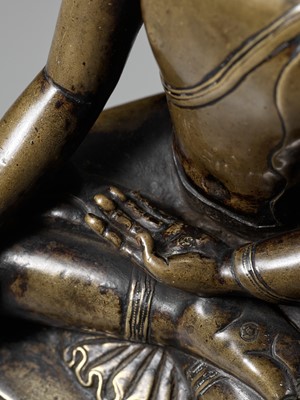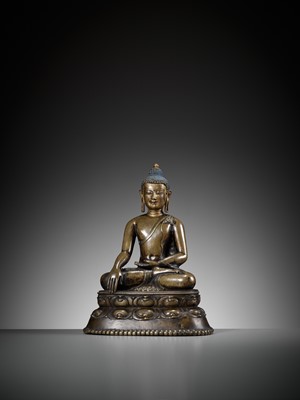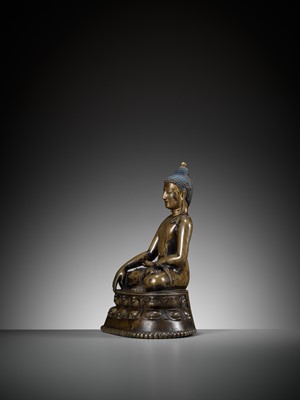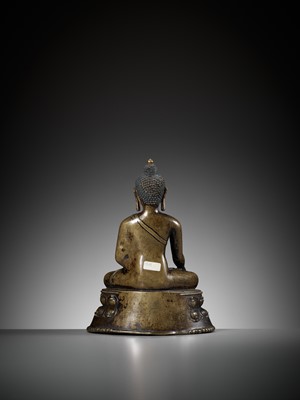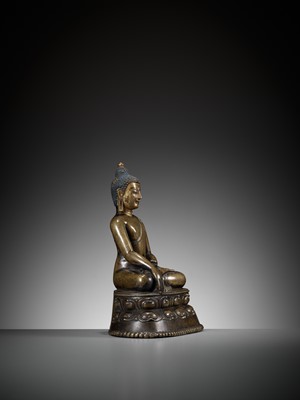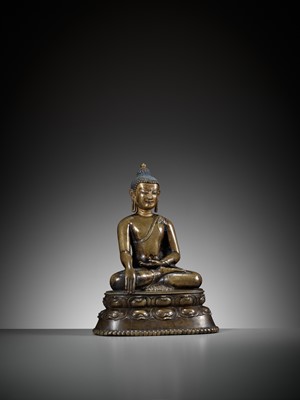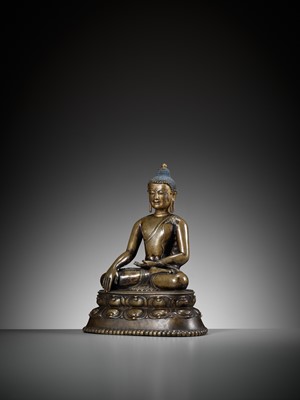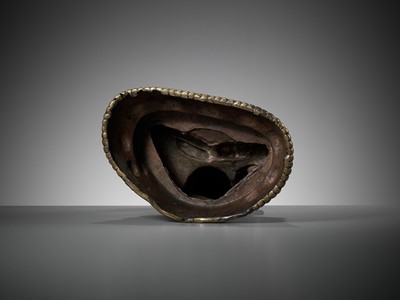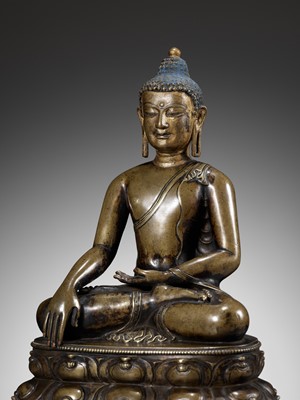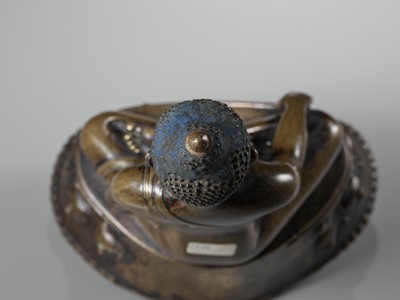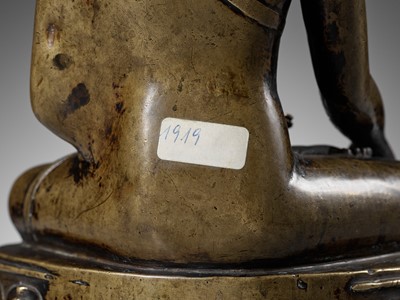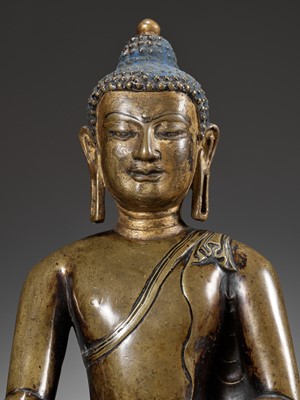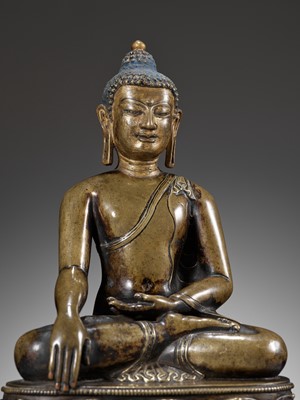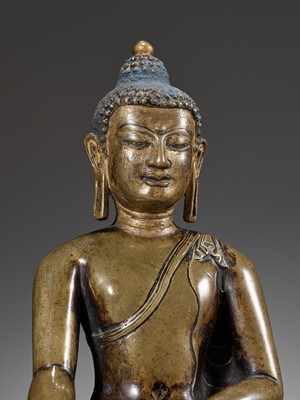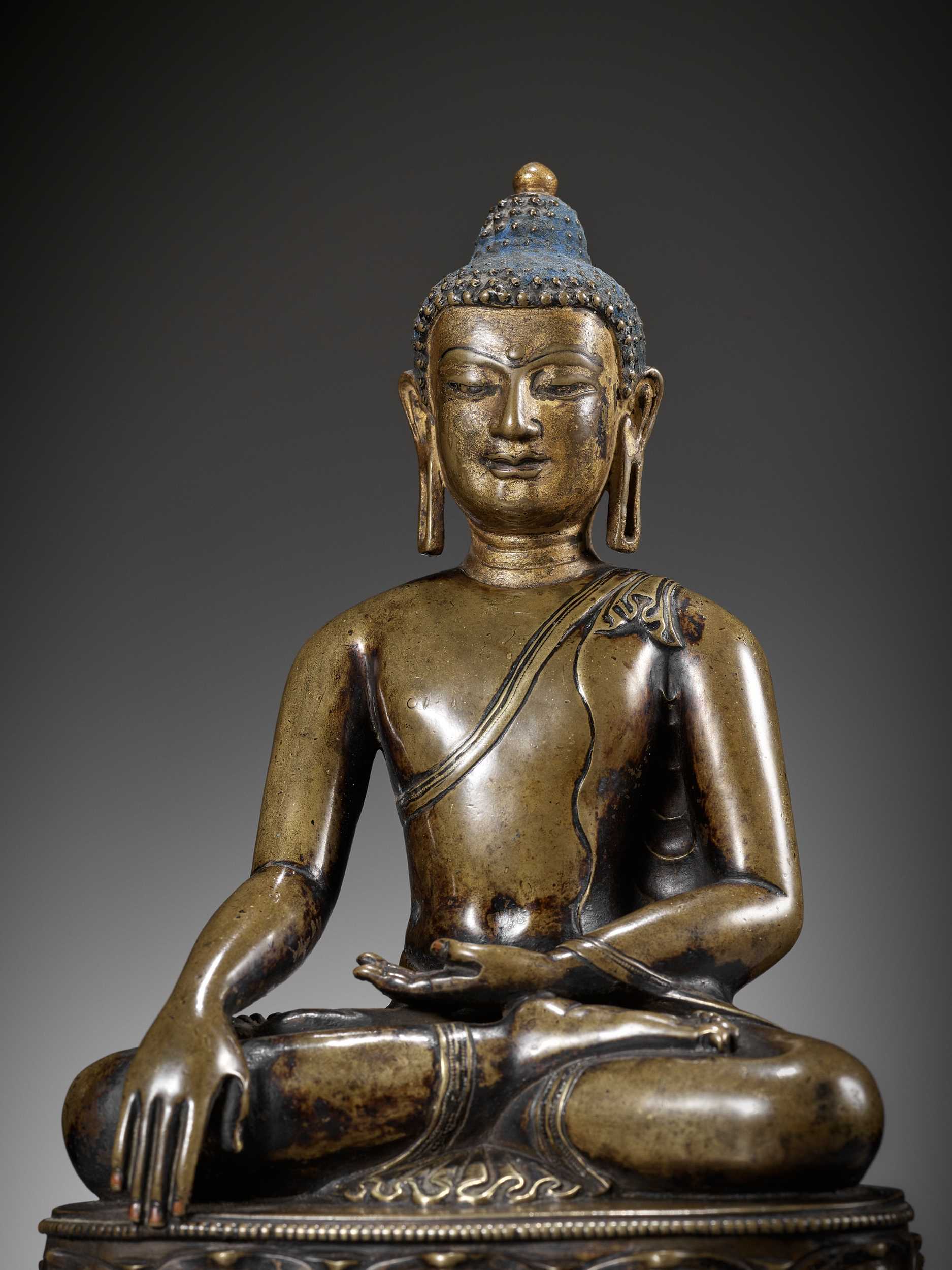29th Sep, 2022 13:00
DAY 1 - TWO-DAY AUCTION - Fine Chinese Art / 中國藝術集珍 / Buddhism & Hinduism
161
A COPPER-INLAID BRASS FIGURE OF BUDDHA VAJRASANA, 12TH-13TH CENTURY
十二至十三世紀錯紅銅金剛座佛陀銅像
Sold for €65,000
including Buyer's Premium
Tibet, circa 1100-1250. Superbly cast, seated in vajraparyankasana on a double lotus throne with remarkably thick-beaded rims, the right hand extended in bhumisparsha mudra and the left in dhyana mudra, the fingernails conspicuously inlaid with copper, his left palm and right sole incised with a floral design. Wearing a sanghati gathered on one shoulder, with distinct wavelike folds hidden in the gap between the body and the left arm, the robe gathering in elegant pleats just below his feet and above a vajra finely incised to the base.
Provenance: Old Austrian private collection.
Condition: Superb condition, commensurate with age. Some wear, casting irregularities, minor dents, few tiny losses, minuscule nicks, light scratches, remnants of ancient pigment and gilding to face, the eyebrows and other areas possibly inlaid with silver wire, which has over the centuries turned completely black and cannot be clearly identified. The base unsealed. Rich, naturally grown patina with an unctuous feel overall, showing signs of extensive worship and caress across the centuries.
Weight: 1,249 g
Dimensions: Height 26 cm
The gilt face is sensitively modeled with a serene expression, the downcast eyes and arched brows seem to be inlaid with metal (possibly silver), the lips with faint remnants of copper inlay, flanked by long pierced pendulous earlobes, the blue hair arranged in tight curls surmounted by a tall ushnisha topped by a bud-shaped jewel.
The bronze depicts Shakyamuni Buddha at the very moment of Enlightenment at Bodh Gaya. Touching the goddess, Earth, with his right hand, he called her to witness his imperturbability in front of the assault of the demon Mara. It is with reference to this condition of serene beatitude that Shakyamuni's epiphany was called Akshobhya, meaning ‘Imperturbable’. The episode took place at the Vajrasana seat at Bodh Gaya, which by tradition was specially empowered to expedite his enlightenment. Later, the followers of Buddhist esoteric schools represented the epiphany with their most important emblem, the vajra, which they interpreted as a symbol of the adamantine purity, indestructibility, and perfection of the Buddhist doctrine. In the present bronze, the vajra is incised into the upper surface of the lotus base.
This sculpture represents the early phase of Tibetan Buddhist art during the Chidar, the Later Diffusion of Faith, that took inspiration from eleventh and twelfth-century Pala-period sculptural traditions of eastern India. Various elements reflect Indian prototypes, including the tall ushnisha and particularly the base's lower rim, distinctively decorated with a single row of large beads. Meanwhile, the base’s high-relief lotus petals with their characteristically incised design are an early Tibetan feature. This combination of stylistic elements exemplifies Tibetan artists' close apprenticeship of Pala art during and shortly after the Chidar.
Literature comparison:
Compare a closely related brass figure of Buddha Shakyamuni, dated 13th-14th century, supported on an altar of probably a later date, the base similarly cast with Pala-influenced beaded rims and Tibetan flattened lotus petals, illustrated in the Complete Collection of the Treasures of the Palace Museum, 60 Buddhist Statues of Tibet, Hong Kong, 1998, pages 160-161, no. 153. This type of base is also seen in three closely related brass figures dated circa 13th century, illustrated by von Schroeder, Buddhist Sculptures in Tibet, Hong Kong, 2001, Volume II, pp. 1173, pls. 313C-E. For the Pala prototype depicting Buddha Vajrasana, dated 11th-12th century, see von Schroeder, Buddhist Sculptures in Tibet, Hong Kong, 2001, Volume I, pp. 269, pl. 86C. Note also the elongated figure, narrow waist and tubular limbs, the distinctive double-tipped petal motif of each bulbous petal on the lotus throne, and the curled double-edges of the sanghati thrown over the proper left shoulder in the figure of Shakyamuni (313D), as well as the gently sloping hairline, ovoid facial shape, raised urna, and the upward-curving eyes inlaid with silver on the figure of Vajrasattva (313C).
Auction result comparison:
Type: Closely related
Auction: Sotheby’s Hong Kong, 2 October 2017, lot 3131
Estimate: HKD 1,500,000 or approx. EUR 203,000 converted and adjusted for inflation at the time of writing
Description: An inscribed early copper-inlaid bronze figure of Shakyamuni Buddha, Tibet, 12th-13th century
Expert remark: Compare the alloy and patina, the pose, robe and hems, the face, and the tall ushnisha with the similarly bud-shaped jewel on top. Note the slightly larger size (29.8 cm).
Auction result comparison:
Type: Closely related
Auction: Bonhams Hong Kong, 2 December 2020, lot 1009
Price: HKD 752,500 or approx. EUR 95,500 converted and adjusted for inflation at the time of writing
Description: A silver and copper inlaid copper alloy figure of Buddha Shakyamuni, Tibet, 13th century
Expert remark: Compare the alloy and patina, the pose, robe and hems, the face, and the tall ushnisha with the similarly bud-shaped jewel on top. Note the larger size (31.8 cm).
十二至十三世紀錯紅銅金剛座佛陀銅像
西藏,約 1100-1250年。鑄工精湛,金剛座佛陀坐於雙蓮座上,連珠紋,右手施觸地印,左手施禪定印,指甲錯紅銅,手掌足心刻花紋。單肩披僧伽,衣褶條紋流暢,有金剛杵。
來源:奧地利私人舊藏。
品相:狀況極佳,與年齡相稱。一些磨損,鑄造不規則,輕微的凹痕,一些微小的缺損,微小的刻痕和劃痕,顏料和面部鎏金殘留,眉毛和其他區域可能錯了銀線,幾個世紀以來已經完全變黑,不能明確標識。底座開封。豐富的自然包漿,整體感覺細膩,顯示出幾個世紀以來極受崇拜和喜愛的跡象。
重量:1,249 克
尺寸:高26 厘米
鎏金的臉部表情平靜,低垂的眼睛和彎彎的眉毛似乎鑲嵌著金屬(可能是銀),嘴唇上有淡淡的錯紅銅殘留物,兩側是長長的穿孔耳垂,藍色的頭髮梳成螺髻,頂部是一個花蕾狀寶石。
這尊面容歡愉的佛像再現佛陀於菩提伽耶悟道之瞬間。佛陀雙目含笑,以尤為和藹可親之神態凝視觀者。右手觸地,召喚她,見證自己在惡魔面前的鎮定自若。釋迦牟尼的頓悟正是基於這種寧靜的幸福狀態。後來,佛教密宗的追隨者用他們最重要的金剛來代表頓悟,他們將其解釋為佛教教義的金剛純潔、堅不可摧和完美的象徵。在現在的銅像上,金剛杵被刻在蓮花座的上表面。
多處細節皆可印證此種印度特徵,如高高聳起的髮髻、寶冠旁的髮帶、珠寶之造型以及蓮花座之連珠紋等等。這件雕塑代表了藏傳佛教藝術在奇達爾時期的早期階段,即後來的信仰擴散,其靈感來自印度東部十一世紀和十二世紀帕拉時期的雕塑傳統。同時,底座的高浮雕蓮花花瓣,其獨特的切割設計是早期的藏族特色。這種風格元素的結合體現了西藏藝術家在奇達爾時期和之後不久對帕拉藝術的密切學習。
文獻比較:
比較一件非常相近的十三至十四世紀釋迦牟尼黃銅像,附有一件年代較晚的底座上,底座同樣鑄有受帕拉時期影響的珠邊和藏式扁平蓮花瓣,見《故宫博物院藏文物珍品全集·藏传佛教造像》,香港,1998年,頁160-161,編號153。另外三見底座非常相近的十三世紀黃銅像,見von Schroeder,《Buddhist Sculptures in Tibet》,香港,2001年,卷二,頁1173,編號313C-E。 一件帕拉時期原型十一至十二世紀佛陀坐像,見von Schroeder,《Buddhist Sculptures in Tibet》,香港,2001年,卷一,頁269,圖86C。請注意,釋迦牟尼的身材修長,腰部狹窄,四肢呈管狀,蓮花寶座上的每一片球狀花瓣都有連珠紋,釋迦牟尼像(313D)的左肩上有捲曲的雙緣,以及金剛薩埵菩薩(313C)的髮際線緩緩傾斜,臉型橢圓,白毫上揚,眼睛向上彎曲並錯銀。
拍賣結果比較:
形制:非常相近
拍賣:香港蘇富比,2017年10月2日,lot 3131
估價:HKD 1,500,000(相當於今日EUR 203,000)
描述:十二至十三世紀西藏銅錯紅銅銘文釋迦牟尼佛坐像
專家評論:比較合金和包漿、姿勢、長袍和下擺、臉部,頭底有以珠寶束成的高髻。請注意尺寸較大(29.8厘米)。
拍賣結果比較:
形制:非常相近
拍賣:邦瀚斯 香港,2020年12月2日, lot 1009
價格:HKD 752,500(相當於今日EUR 95,500)
描述:西藏十三世紀錯銀錯紅銅釋迦牟尼銅像
專家評論:比較合金和包漿、姿勢、長袍和下擺、臉部,頭底有以珠寶束成的高髻。請注意尺寸較大(31.8厘米)。
Tibet, circa 1100-1250. Superbly cast, seated in vajraparyankasana on a double lotus throne with remarkably thick-beaded rims, the right hand extended in bhumisparsha mudra and the left in dhyana mudra, the fingernails conspicuously inlaid with copper, his left palm and right sole incised with a floral design. Wearing a sanghati gathered on one shoulder, with distinct wavelike folds hidden in the gap between the body and the left arm, the robe gathering in elegant pleats just below his feet and above a vajra finely incised to the base.
Provenance: Old Austrian private collection.
Condition: Superb condition, commensurate with age. Some wear, casting irregularities, minor dents, few tiny losses, minuscule nicks, light scratches, remnants of ancient pigment and gilding to face, the eyebrows and other areas possibly inlaid with silver wire, which has over the centuries turned completely black and cannot be clearly identified. The base unsealed. Rich, naturally grown patina with an unctuous feel overall, showing signs of extensive worship and caress across the centuries.
Weight: 1,249 g
Dimensions: Height 26 cm
The gilt face is sensitively modeled with a serene expression, the downcast eyes and arched brows seem to be inlaid with metal (possibly silver), the lips with faint remnants of copper inlay, flanked by long pierced pendulous earlobes, the blue hair arranged in tight curls surmounted by a tall ushnisha topped by a bud-shaped jewel.
The bronze depicts Shakyamuni Buddha at the very moment of Enlightenment at Bodh Gaya. Touching the goddess, Earth, with his right hand, he called her to witness his imperturbability in front of the assault of the demon Mara. It is with reference to this condition of serene beatitude that Shakyamuni's epiphany was called Akshobhya, meaning ‘Imperturbable’. The episode took place at the Vajrasana seat at Bodh Gaya, which by tradition was specially empowered to expedite his enlightenment. Later, the followers of Buddhist esoteric schools represented the epiphany with their most important emblem, the vajra, which they interpreted as a symbol of the adamantine purity, indestructibility, and perfection of the Buddhist doctrine. In the present bronze, the vajra is incised into the upper surface of the lotus base.
This sculpture represents the early phase of Tibetan Buddhist art during the Chidar, the Later Diffusion of Faith, that took inspiration from eleventh and twelfth-century Pala-period sculptural traditions of eastern India. Various elements reflect Indian prototypes, including the tall ushnisha and particularly the base's lower rim, distinctively decorated with a single row of large beads. Meanwhile, the base’s high-relief lotus petals with their characteristically incised design are an early Tibetan feature. This combination of stylistic elements exemplifies Tibetan artists' close apprenticeship of Pala art during and shortly after the Chidar.
Literature comparison:
Compare a closely related brass figure of Buddha Shakyamuni, dated 13th-14th century, supported on an altar of probably a later date, the base similarly cast with Pala-influenced beaded rims and Tibetan flattened lotus petals, illustrated in the Complete Collection of the Treasures of the Palace Museum, 60 Buddhist Statues of Tibet, Hong Kong, 1998, pages 160-161, no. 153. This type of base is also seen in three closely related brass figures dated circa 13th century, illustrated by von Schroeder, Buddhist Sculptures in Tibet, Hong Kong, 2001, Volume II, pp. 1173, pls. 313C-E. For the Pala prototype depicting Buddha Vajrasana, dated 11th-12th century, see von Schroeder, Buddhist Sculptures in Tibet, Hong Kong, 2001, Volume I, pp. 269, pl. 86C. Note also the elongated figure, narrow waist and tubular limbs, the distinctive double-tipped petal motif of each bulbous petal on the lotus throne, and the curled double-edges of the sanghati thrown over the proper left shoulder in the figure of Shakyamuni (313D), as well as the gently sloping hairline, ovoid facial shape, raised urna, and the upward-curving eyes inlaid with silver on the figure of Vajrasattva (313C).
Auction result comparison:
Type: Closely related
Auction: Sotheby’s Hong Kong, 2 October 2017, lot 3131
Estimate: HKD 1,500,000 or approx. EUR 203,000 converted and adjusted for inflation at the time of writing
Description: An inscribed early copper-inlaid bronze figure of Shakyamuni Buddha, Tibet, 12th-13th century
Expert remark: Compare the alloy and patina, the pose, robe and hems, the face, and the tall ushnisha with the similarly bud-shaped jewel on top. Note the slightly larger size (29.8 cm).
Auction result comparison:
Type: Closely related
Auction: Bonhams Hong Kong, 2 December 2020, lot 1009
Price: HKD 752,500 or approx. EUR 95,500 converted and adjusted for inflation at the time of writing
Description: A silver and copper inlaid copper alloy figure of Buddha Shakyamuni, Tibet, 13th century
Expert remark: Compare the alloy and patina, the pose, robe and hems, the face, and the tall ushnisha with the similarly bud-shaped jewel on top. Note the larger size (31.8 cm).
十二至十三世紀錯紅銅金剛座佛陀銅像
西藏,約 1100-1250年。鑄工精湛,金剛座佛陀坐於雙蓮座上,連珠紋,右手施觸地印,左手施禪定印,指甲錯紅銅,手掌足心刻花紋。單肩披僧伽,衣褶條紋流暢,有金剛杵。
來源:奧地利私人舊藏。
品相:狀況極佳,與年齡相稱。一些磨損,鑄造不規則,輕微的凹痕,一些微小的缺損,微小的刻痕和劃痕,顏料和面部鎏金殘留,眉毛和其他區域可能錯了銀線,幾個世紀以來已經完全變黑,不能明確標識。底座開封。豐富的自然包漿,整體感覺細膩,顯示出幾個世紀以來極受崇拜和喜愛的跡象。
重量:1,249 克
尺寸:高26 厘米
鎏金的臉部表情平靜,低垂的眼睛和彎彎的眉毛似乎鑲嵌著金屬(可能是銀),嘴唇上有淡淡的錯紅銅殘留物,兩側是長長的穿孔耳垂,藍色的頭髮梳成螺髻,頂部是一個花蕾狀寶石。
這尊面容歡愉的佛像再現佛陀於菩提伽耶悟道之瞬間。佛陀雙目含笑,以尤為和藹可親之神態凝視觀者。右手觸地,召喚她,見證自己在惡魔面前的鎮定自若。釋迦牟尼的頓悟正是基於這種寧靜的幸福狀態。後來,佛教密宗的追隨者用他們最重要的金剛來代表頓悟,他們將其解釋為佛教教義的金剛純潔、堅不可摧和完美的象徵。在現在的銅像上,金剛杵被刻在蓮花座的上表面。
多處細節皆可印證此種印度特徵,如高高聳起的髮髻、寶冠旁的髮帶、珠寶之造型以及蓮花座之連珠紋等等。這件雕塑代表了藏傳佛教藝術在奇達爾時期的早期階段,即後來的信仰擴散,其靈感來自印度東部十一世紀和十二世紀帕拉時期的雕塑傳統。同時,底座的高浮雕蓮花花瓣,其獨特的切割設計是早期的藏族特色。這種風格元素的結合體現了西藏藝術家在奇達爾時期和之後不久對帕拉藝術的密切學習。
文獻比較:
比較一件非常相近的十三至十四世紀釋迦牟尼黃銅像,附有一件年代較晚的底座上,底座同樣鑄有受帕拉時期影響的珠邊和藏式扁平蓮花瓣,見《故宫博物院藏文物珍品全集·藏传佛教造像》,香港,1998年,頁160-161,編號153。另外三見底座非常相近的十三世紀黃銅像,見von Schroeder,《Buddhist Sculptures in Tibet》,香港,2001年,卷二,頁1173,編號313C-E。 一件帕拉時期原型十一至十二世紀佛陀坐像,見von Schroeder,《Buddhist Sculptures in Tibet》,香港,2001年,卷一,頁269,圖86C。請注意,釋迦牟尼的身材修長,腰部狹窄,四肢呈管狀,蓮花寶座上的每一片球狀花瓣都有連珠紋,釋迦牟尼像(313D)的左肩上有捲曲的雙緣,以及金剛薩埵菩薩(313C)的髮際線緩緩傾斜,臉型橢圓,白毫上揚,眼睛向上彎曲並錯銀。
拍賣結果比較:
形制:非常相近
拍賣:香港蘇富比,2017年10月2日,lot 3131
估價:HKD 1,500,000(相當於今日EUR 203,000)
描述:十二至十三世紀西藏銅錯紅銅銘文釋迦牟尼佛坐像
專家評論:比較合金和包漿、姿勢、長袍和下擺、臉部,頭底有以珠寶束成的高髻。請注意尺寸較大(29.8厘米)。
拍賣結果比較:
形制:非常相近
拍賣:邦瀚斯 香港,2020年12月2日, lot 1009
價格:HKD 752,500(相當於今日EUR 95,500)
描述:西藏十三世紀錯銀錯紅銅釋迦牟尼銅像
專家評論:比較合金和包漿、姿勢、長袍和下擺、臉部,頭底有以珠寶束成的高髻。請注意尺寸較大(31.8厘米)。
Zacke Live Online Bidding
Our online bidding platform makes it easier than ever to bid in our auctions! When you bid through our website, you can take advantage of our premium buyer's terms without incurring any additional online bidding surcharges.
To bid live online, you'll need to create an online account. Once your account is created and your identity is verified, you can register to bid in an auction up to 12 hours before the auction begins.
Intended Spend and Bid Limits
When you register to bid in an online auction, you will need to share your intended maximum spending budget for the auction. We will then review your intended spend and set a bid limit for you. Once you have pre-registered for a live online auction, you can see your intended spend and bid limit by going to 'Account Settings' and clicking on 'Live Bidding Registrations'.
Your bid limit will be the maximum amount you can bid during the auction. Your bid limit is for the hammer price and is not affected by the buyer’s premium and VAT. For example, if you have a bid limit of €1,000 and place two winning bids for €300 and €200, then you will only be able to bid €500 for the rest of the auction. If you try to place a bid that is higher than €500, you will not be able to do so.
Online Absentee and Telephone Bids
You can now leave absentee and telephone bids on our website!
Absentee Bidding
Once you've created an account and your identity is verified, you can leave your absentee bid directly on the lot page. We will contact you when your bids have been confirmed.
Telephone Bidding
Once you've created an account and your identity is verified, you can leave telephone bids online. We will contact you when your bids have been confirmed.
Classic Absentee and Telephone Bidding Form
You can still submit absentee and telephone bids by email or fax if you prefer. Simply fill out the Absentee Bidding/Telephone bidding form and return it to us by email at office@zacke.at or by fax at +43 (1) 532 04 52 20. You can download the PDF from our Upcoming Auctions page.
How-To Guides
How to Create Your Personal Zacke Account
How to Register to Bid on Zacke Live
How to Leave Absentee Bids Online
How to Leave Telephone Bids Online
中文版本的操作指南
创建新账号
注册Zacke Live在线直播竞拍(免平台费)
缺席投标和电话投标
Third-Party Bidding
We partner with best-in-class third-party partners to make it easy for you to bid online in the channel of your choice. Please note that if you bid with one of our third-party online partners, then there will be a live bidding surcharge on top of your final purchase price. You can find all of our fees here. Here's a full list of our third-party partners:
- 51 Bid Live
- EpaiLive
- ArtFoxLive
- Invaluable
- LiveAuctioneers
- the-saleroom
- lot-tissimo
- Drouot
Please note that we place different auctions on different platforms. For example, in general, we only place Chinese art auctions on 51 Bid Live.
Bidding in Person
You must register to bid in person and will be assigned a paddle at the auction. Please contact us at office@zacke.at or +43 (1) 532 04 52 for the latest local health and safety guidelines.
